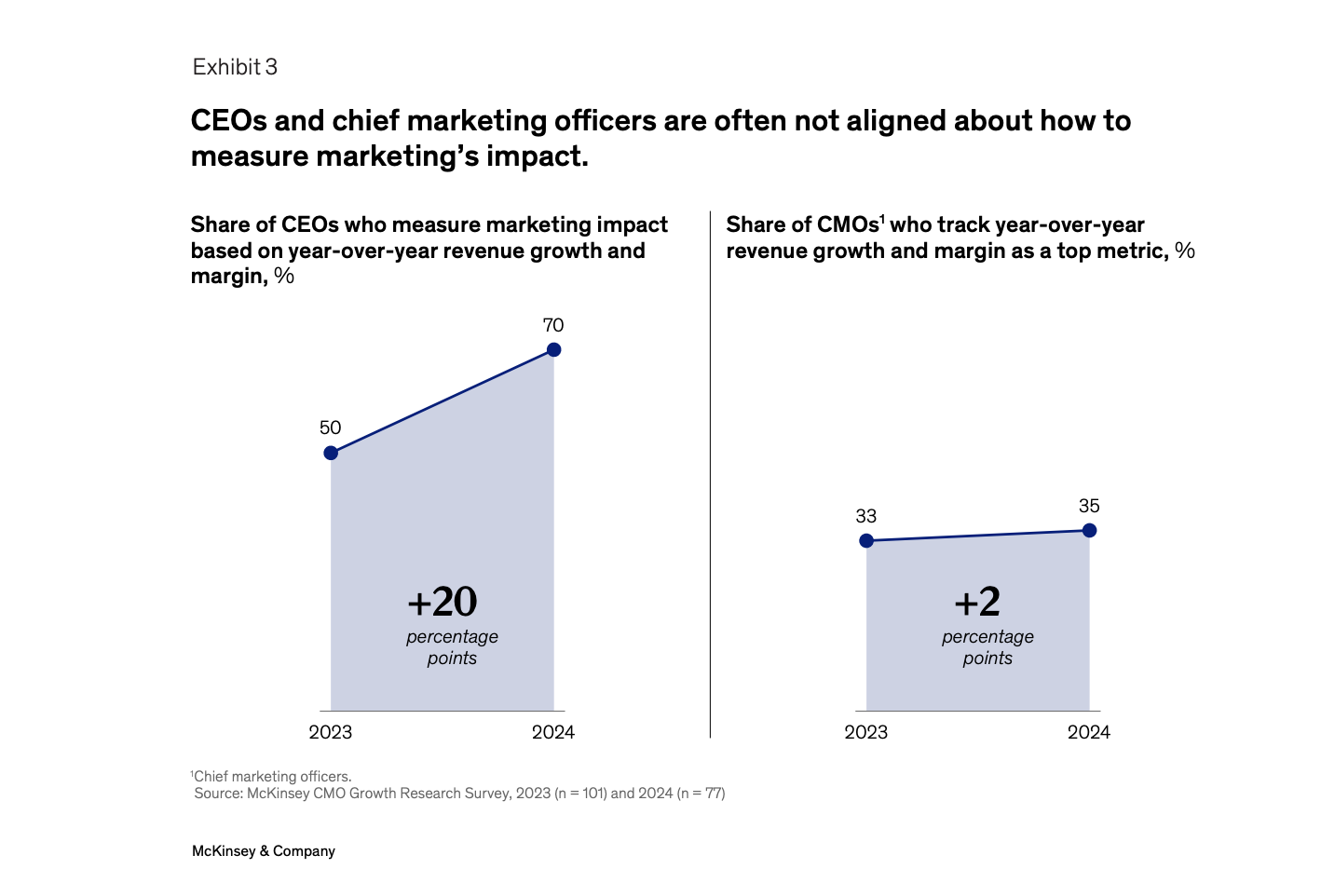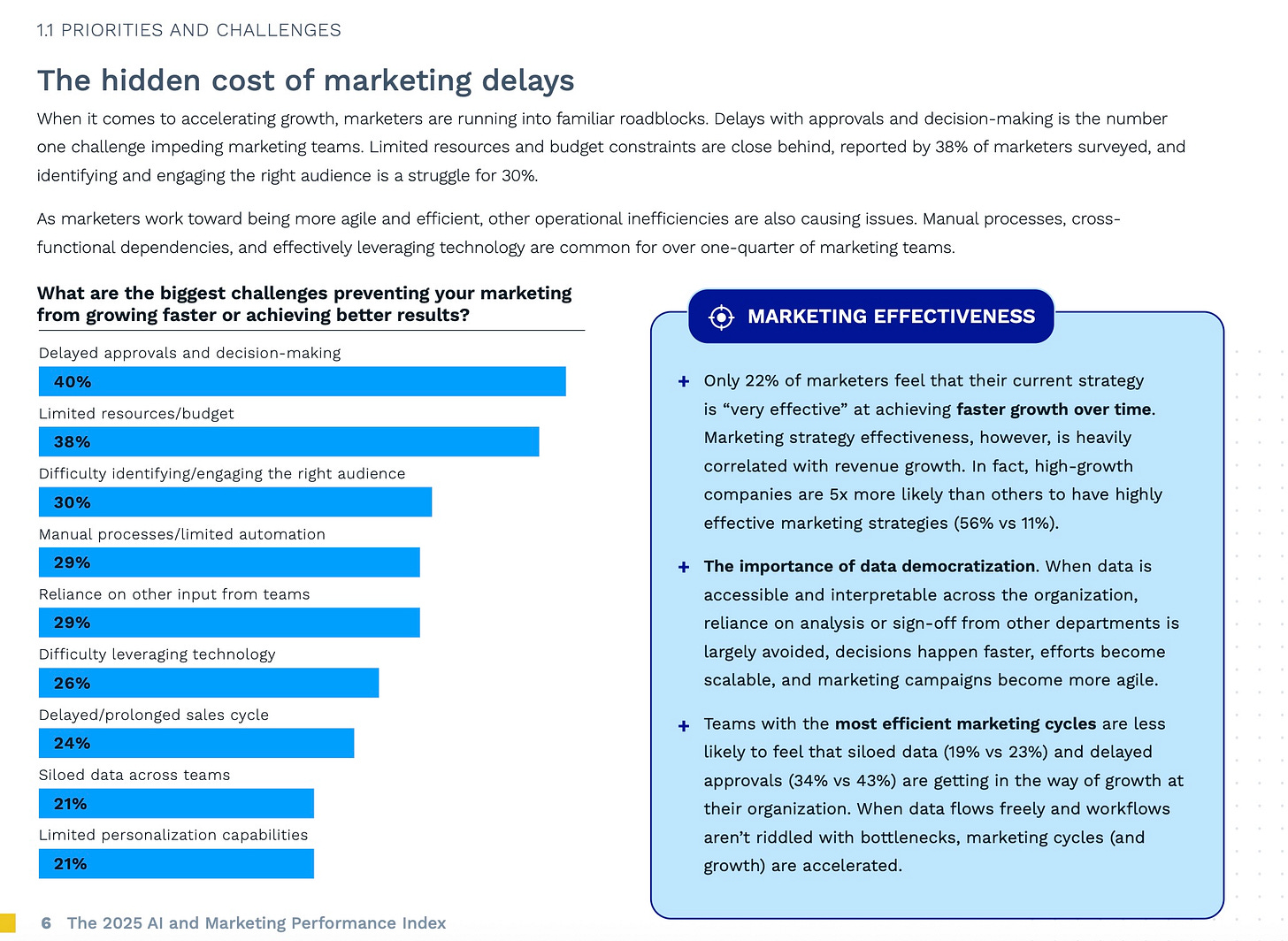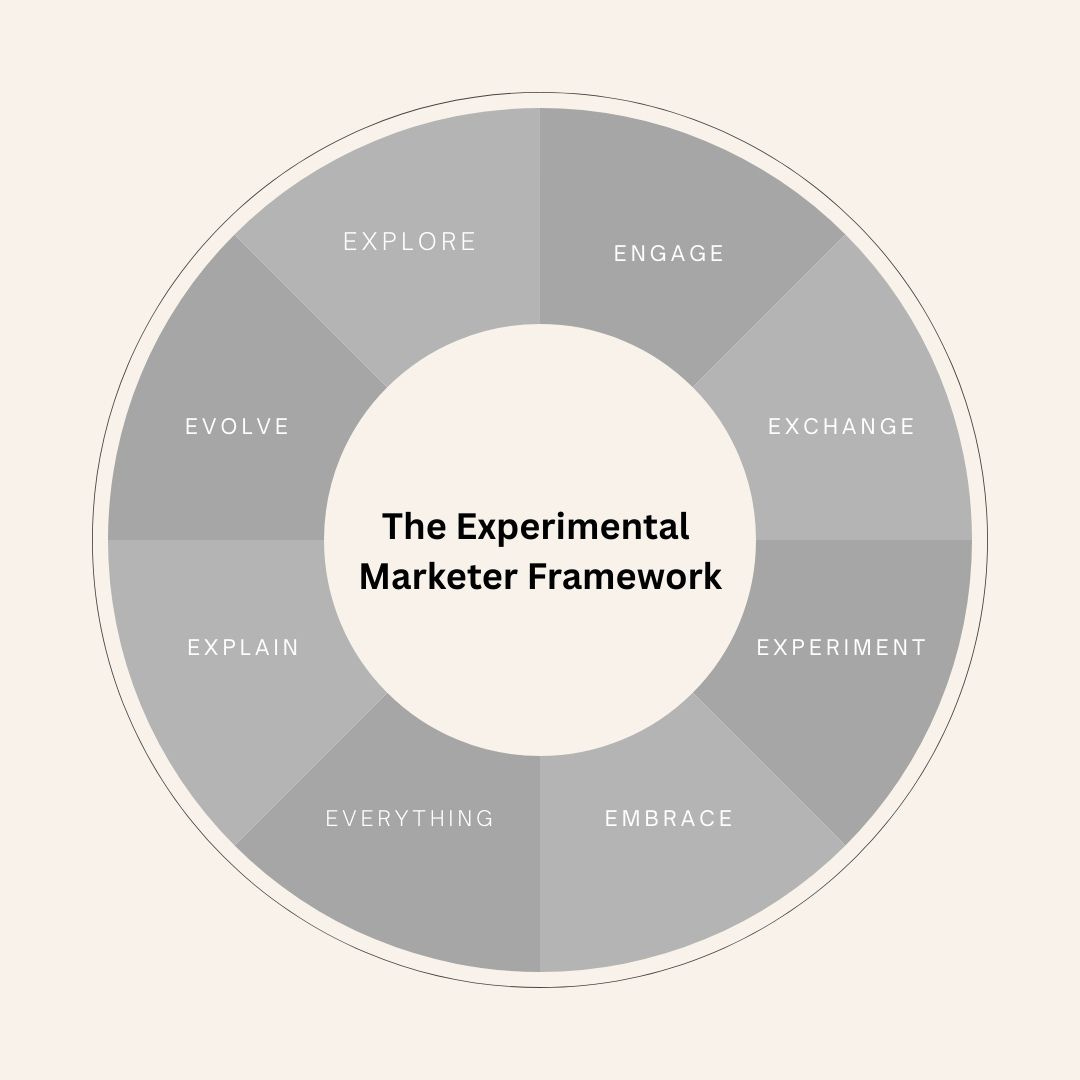Bridging the Gap Between Marketing Execution and C-Suite Expectations
The Experimental Marketer Framework to the Marketer's Rescue!
As many of you already know, throughout my career I have seen the same issues around marketers and technology over and over again. To help me, I ended up creating the Experimental Marketer Framework. This framework can also help other marketers make marketing technology work for them. The post below is another attempt to explain the benefits of this framework and its 8 Es, by using 2 recently published reports: one from a martech vendor called GrowthLoop and the other my consultant behemoth McKenzie & Company. Curiously, in its report titled “The CMO’s comeback: Aligning the C-suite to drive customer-centric growth”, the authors make the case that marketers are integrators (yes, they even used the word), moving through different teams and responsibilities as the overall manager of the customer experience. This resonated profoundly with me, as it is the core of the Experimental Marketing framework I created based on my own experience (as an integrator of sorts many, times over!).
Below you will read the analysis of these two reports and how the Experimental Marketer Framework can help move marketers towards more engaging customer activities and faster, more agile marketing processes.
I hope you enjoy. Please feel free to send me your comments!
_________________________________________________________________
Marketers from all industries seem to be living in a paradox. Marketing teams are running faster than ever, implementing cutting-edge AI tools and sophisticated campaigns, yet somehow the CMO is losing their seat at the executive table. Recent research reveals that 89% of marketers report feeling increased pressure to deliver better results in less time, while simultaneously, the number of CMOs at Fortune 500 companies has dropped from 71% to 66% in just one year. Marketing has never been more capable, yet it's sliding to the back seat just when companies need customer-centric growth the most.
This disconnect isn't just an organizational hiccup; it's a fundamental misalignment that's costing companies real growth opportunities. When companies have many job titles responsible for the customer, no one truly owns them, and marketing, despite being the natural customer champion, finds itself fragmented across multiple functions and relegated to tactical execution rather than strategic leadership.
The Misalignment Crisis: When Capability Meets Confusion
The data paints a sobering picture of modern marketing's predicament. While 89% of marketers face mounting pressure to perform, only 22% feel their current marketing approach effectively achieves faster growth over time. Even more telling, 70% of CEOs measure marketing's impact based on year-over-year revenue growth, but only 35% of CMOs track this as a top metric. The language of impact isn't translating across the C-suite, creating what McKinsey describes as a "choppy customer journey" where different departments deliver conflicting messages to the same customers (and customer data live in silos throughout the company).
This misalignment is also self-inflicted. Marketing responsibilities have become fragmented across digital officers, commercial officers, and data officers, while 40% of marketers cite delayed approvals and decision-making as their biggest growth barrier. Meanwhile, 53% identify data analysis and insights as the primary bottleneck in their marketing cycles—a clear indicator that the promise of marketing technology hasn't translated into operational excellence needed to demonstrate clear business impact.
Inefficient processes are also contributing and cannot be solved just by updating tools and platforms. Despite AI adoption accelerating and tools becoming more sophisticated, two-thirds of marketers still describe their campaign cycles as suboptimal. Data remains siloed across platforms, processes stay manual despite automation tools, and marketing teams find themselves explaining their value rather than obviously delivering it. The GrowthLoop research reveals that teams currently using AI are more likely to have marketing cycles under 30 days compared to those that don't, yet most organizations haven't built the systematic approaches (aka improve their marketing processes) needed to harness this advantage.
Root Causes: Why Marketing Creates These Gaps
What is now considered “traditional” marketing inadvertently creates the very disconnects they aim to solve. When marketing teams focus primarily on top-of-funnel activities like advertising and promotion, they miss opportunities to demonstrate system-wide impact through comprehensive customer data strategies. This narrow focus makes it difficult to speak the language of revenue growth and business outcomes that resonates with CFOs and CEOs and their organizations.
In my experience, the problem even deepens when marketing delegates strategic technology decisions to IT or external vendors without understanding how customer data flows through the organization. Most marketing teams may only leverage a fraction of available customer data because they can view each platform in isolation rather than as part of an interconnected ecosystem. They collect website behavior, purchase history, email engagement, and social media interactions, etc, across multiple touchpoints, yet may be unable to create the holistic customer intelligence that drives sustainable competitive advantage (as this can also require more technical help from other teams/vendors).
Communication barriers emerge because marketing teams become fluent in their own metrics (click-through rates, brand awareness, engagement scores) without translating these into the business outcomes that matter to the broader organization. When a CMO reports strong brand metrics while the CFO shares declining revenue, the disconnect becomes painfully obvious to everyone in the room.
The Experimental Marketer Solution: A Strategic Framework for Modern Marketing
The Experimental Marketer framework offers a systematic approach to bridging these gaps through seven interconnected principles that transform marketers from tactical executors into strategic growth partners. This framework directly addresses McKinsey's call for marketers to develop "T-shaped" skills while building the cross-functional relationships essential for modern marketing success.
Explore: Platforms, Connections, and Customer Data Opportunities
The exploration mindset requires marketers to become organizational detectives, systematically mapping not just what tools they have, but how data flows between systems and where strategic opportunities hide. This goes far beyond traditional campaign planning to include comprehensive audits of customer touchpoints and cross-departmental data assets that most marketers overlook.
Modern brands collect customer interactions across multiple touchpoints, yet most marketing teams only leverage a fraction of this data because they lack systematic exploration processes. The GrowthLoop research showing that 53% of marketers identify data analysis as their biggest bottleneck directly connects to this exploration challenge—teams can't analyze what they haven't properly discovered and mapped.
Successful exploration involves engaging with teams beyond marketing. Customer service controls product feedback data, sales teams have direct customer insight conversations, and product teams understand usage patterns that could dramatically enhance marketing effectiveness. When marketers lead these cross-functional discovery efforts, they position themselves as strategic connectors rather than isolated campaign executors.
Engage: Building Stakeholder Buy-In and Cross-Team Collaboration
Engagement represents the political and collaborative intelligence that McKinsey identifies as essential for modern marketing success. This isn't about convincing others to support marketing initiatives—it's about aligning marketing goals with organizational objectives and demonstrating shared value across multiple stakeholder interests.
The most successful experimental marketers become bilingual, speaking both marketing language and the language of their stakeholders. IT teams care about data security and system reliability, legal teams focus on risk mitigation and privacy protection, finance teams prioritize ROI measurement and cost efficiency, while executive leadership seeks competitive advantage and scalable growth. Marketing initiatives fail more often due to lack of stakeholder buy-in than due to poor strategy or execution.
This engagement capability directly addresses the misalignment crisis revealed in the research. When marketers can translate their customer data initiatives into language that resonates with legal compliance, financial performance, and operational efficiency, they build the organizational support necessary for strategic influence rather than tactical isolation.
Exchange: Collaborative Data Activation and Process Optimization
Exchange represents the operational heart of experimental marketing—the ongoing, iterative collaboration that turns static customer data into dynamic marketing advantage. This addresses the core challenge identified in both McKinsey and GrowthLoop research: organizations have sophisticated tools but lack the systematic processes to activate data effectively across teams and touchpoints.
The exchange process involves creating dedicated workflows for combining behavioral data, transactional data, and customer attribute data into cohesive intelligence that drives personalized experiences while streamlining data privacy and security processes. This isn't a one-time integration project; it's building organizational muscle for continuous learning and adaptation that requires strategic thinking to establish optimal processes and governance across different teams.
Modern customer data exchange goes beyond moving information between systems—it creates organizational intelligence that compounds over time and becomes harder for competitors to replicate. When marketers lead these exchange initiatives, they demonstrate the systematic business thinking that elevates marketing from cost center to strategic growth driver.
Experiment: Systematic Testing Using Customer Data Intelligence
Experimentation transforms marketing from expensive guesswork into systematic business intelligence. The GrowthLoop research revealing that high-growth companies are significantly more likely to use AI for predicting customer behavior and accelerating campaign execution directly supports this experimental approach—systematic testing using comprehensive customer data creates sustainable competitive advantages.
Modern experimentation goes beyond simple A/B testing to include multivariate testing, incrementality analysis, and even casual predicitive modeling that helps organizations understand not just what works, but why it works and for which customer segments. This systematic approach to learning addresses the McKinsey finding that only 22% of marketers feel their current approach effectively achieves faster growth—experimental marketers build learning systems that compound insights over time.
The experimental mindset also addresses the pressure revealed in the research data. When marketers can demonstrate systematic learning and measurable improvement through rigorous testing, they build credibility for continued investment and strategic influence rather than being viewed as overhead during challenging periods.
Embrace: Adaptive Systems for Constant Change
Embrace represents the psychological and operational flexibility that separates successful experimental marketers from those who get overwhelmed by industry evolution. This directly addresses the rapid changes affecting modern marketing—privacy regulation evolution, AI advancement, and shifting customer expectations around personalization and data usage.
Building adaptive marketing systems means preparing for multiple possible futures rather than betting on single outcomes. The research showing that 45% of marketers cite data security concerns as barriers to AI adoption while 37% struggle with system integration challenges underscores the need for flexible architecture that can evolve without complete overhaul.
Marketers who embrace change don't resist industry evolution or attempt to maintain status quo strategies. Instead, they build capabilities that perform well across multiple scenarios, positioning themselves as strategic guides during periods of uncertainty rather than victims of circumstance.
Everything: Comprehensive Measurement and Business Connection
Everything represents the analytical and communication capabilities that transform marketing from a cost center into a strategic growth driver. This directly addresses the measurement misalignment revealed in the research—while 70% of CEOs measure marketing impact through revenue growth, only 35% of CMOs track this as a primary metric.
Comprehensive measurement means building intelligence systems that connect customer-level activities to business-level outcomes using customer data insights. This includes business outcome translation that converts marketing metrics into strategic business intelligence.
Modern measurement excellence goes beyond tracking more metrics as it builds decision-making intelligence that improves marketing resource allocation and demonstrates strategic value. When marketers master comprehensive measurement, they can provide both operational insights for marketing teams and strategic intelligence for executive decision-making.
Explain: Strategic Communication and Organizational Influence
Explain represents the communication and influence capabilities that ensure experimental marketing strategies receive organizational support needed for long-term success. The research showing that marketing teams with strong internal communication capabilities receive significantly more budget approval and cross-functional collaboration directly validates this principle's importance.
Effective explanation involves helping stakeholders understand how privacy-compliant first-party data strategies benefit customers, comply with regulations, and create sustainable competitive advantages that extend beyond marketing effectiveness, etc. This communication capability transforms complex marketing concepts into compelling narratives that build organizational understanding and support.
Strategic explanation is about connecting marketing activities to outcomes that matter to each stakeholder group while building organizational intelligence about customer behavior and market dynamics. When marketers excel at explanation, they become internal consultants who influence business strategy rather than order-takers who execute campaigns.
Your Role as a Strategic Bridge
The gap between marketing's potential and its organizational reality won't close automatically. It requires marketers at every level—especially managers and directors who bridge execution and strategy—to adopt new approaches and demonstrate new capabilities. The Experimental Marketer framework provides the roadmap for transforming from tactical executors into strategic growth partners.
The pressure you're feeling isn't just about doing more—it's about doing differently. When you master the systematic exploration of customer data opportunities, build stakeholder engagement across organizational functions, create exchange processes that activate data intelligence, experiment with scientific rigor, embrace change as competitive advantage, measure everything that drives business outcomes, and explain marketing value in strategic business language, you transform both your career trajectory and marketing's organizational influence.
The organizations that will dominate their markets are those with marketers who treat customer data as a strategic asset requiring systematic development and activation. They don't just use data to optimize existing campaigns—they build comprehensive customer intelligence that drives sustainable competitive advantage and positions marketing as the indispensable customer champion the C-suite needs for growth.
Ready to bridge the gap? The Experimental Marketer framework offers a proven path from tactical execution to strategic leadership. Start with systematic exploration of your customer data opportunities, then build the stakeholder relationships that will support your transformation into an indispensable strategic growth partner.
Research Methodology and Limitations of Each Report Used
The insights presented in this post draw from two significant research studies, each with distinct methodologies and limitations worth understanding:
McKinsey CMO Growth Research Survey (2024) McKinsey's findings come from their second annual CMO Growth Research Survey, conducted in partnership with the Association of National Advertisers (ANA). The study gathered perspectives from over 100 Fortune 1000 companies across Asia, Europe, Latin America, and the United States, including more than 75 CEOs and CMOs, with CFOs included for the first time in 2024. The research methodology combined quantitative surveys with qualitative interviews to assess CEO-CMO relationships and marketing's role in driving growth.
Key limitations include the focus on large enterprises (Fortune 1000), which may not reflect challenges faced by mid-market or smaller companies. The survey's geographic distribution could also influence findings, as marketing practices and C-suite dynamics vary significantly across regions. Additionally, the annual nature of the survey means some insights reflect year-over-year changes that might represent temporary market conditions rather than permanent trends.
GrowthLoop AI and Marketing Performance Index (2025) GrowthLoop's research, conducted in partnership with Ascend2 Research, surveyed 309 marketing professionals from companies with $100M+ in revenue across the United States and Canada. The study focused specifically on AI adoption, marketing cycle efficiency, and performance measurement, with respondents holding manager-level positions or above. The survey was fielded in April 2025, providing recent insights into AI's impact on marketing operations.
This research's limitations include its geographic concentration in North America, potentially missing global perspectives on AI adoption and marketing practices. The focus on larger companies ($100M+ revenue) may not capture the experiences of smaller organizations with different resource constraints and technology adoption patterns. Additionally, the timing of the survey—during a period of rapid AI evolution—means findings may quickly become outdated as technology and adoption patterns continue evolving.
Both studies provide valuable insights into marketing's current challenges and opportunities, but readers should consider these methodological boundaries when applying findings to their specific organizational contexts. The convergence of findings across both studies strengthens confidence in the core insights about marketing's alignment challenges and the pressure marketers face to demonstrate business impact.




